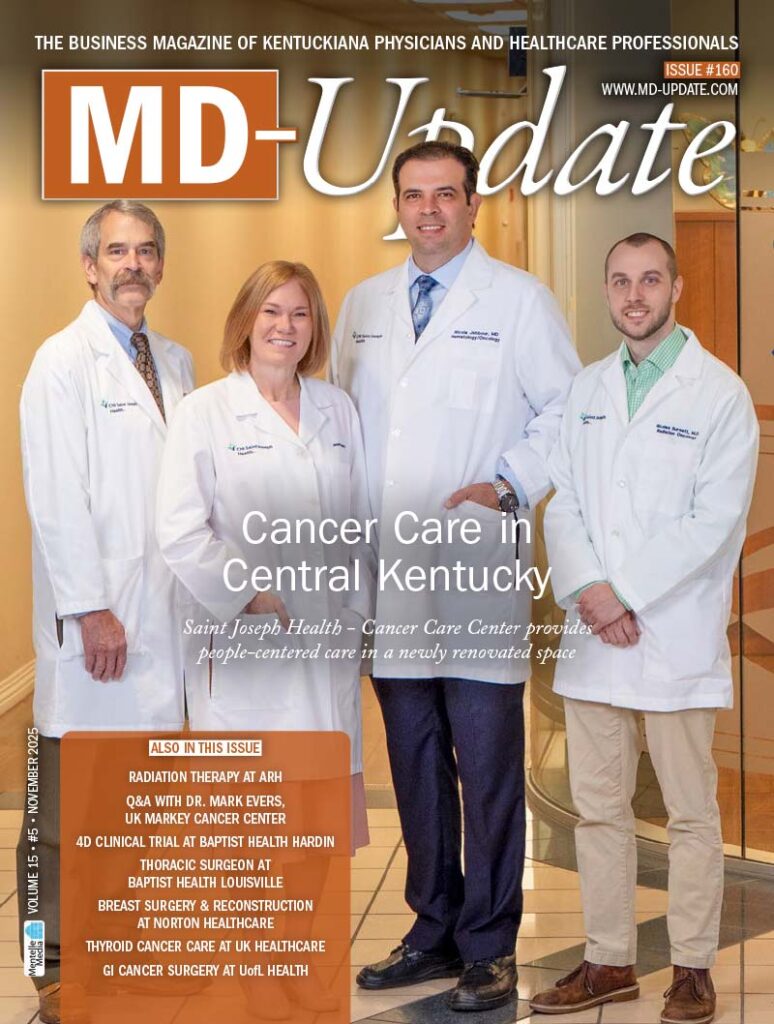BOWLING GREEN The saying goes, “An ounce of prevention is worth a pound of cure.” A more practical way of saying it might be, “A few minutes of conversation is worth thousands – even millions — of dollars.”
With today’s healthcare costs, any procedure, any medication, any treatment that can be avoided means tangible savings to patients and the communities in which they live and work.
Graves Gilbert Clinic in Bowling Green, Ky., prides itself on delivering high-quality, low-cost care.
“The most important intervention is the physician talking to the patient,” says Sandeep Chhabra, MD, an interventional cardiologist at Graves Gilbert. “Each patient is unique in their needs. Their treatment plan and care plan and prevention plan is individualized by a team approach.”
That team approach is optimized by the unique structure of Graves Gilbert, a physician-owned multispecialty clinic founded in 1937 by Dr. Graves and Dr. Gilbert. Graves Gilbert now includes 170 physicians covering 30 specialties. The result is that the patient has access to a wealth of resources, all in one place. Collaboration between physicians is the norm, as is a devised treatment plan which can be thoroughly communicated to the patient. An informed and engaged patient is better equipped to manage their own care, be it preventive or recovery.
The efforts of the clinic to provide their patients with preventive treatment plans resulted in a 100 percent quality score from the federal government in 2016. Nearly 400 Medicare Accountable Care Organizations (ACOs) were included in the evaluation, and only four received the 100 percent quality score. In addition to the quality of care rating, Graves Gilbert’s preventative, collaborative approach saved the government an estimated $12 million in Medicare costs in 2016.
“Our focus on preventative population medicine is what puts us on the forefront of medicine in the 21st century,” says Chhabra, who completed his interventional cardiology training at Mt. Sinai Hospital in Manhattan before coming to Graves Gilbert in 2011. “The integration of the primary care and the specialty care that we have allows us to become more effective in implementing the preventative strategies to improve the health of the community, as well as be able to help them in their sickness.”
Minimally Invasive Cardiovascular Procedures
The cardiology team at Graves Gilbert treats a wide spectrum of patients with common presentations including blockages in the heart, arrhythmias, and peripheral vascular disease.
Chhabra specializes in high-risk procedures such as high-risk coronary interventions, high-risk valve interventions, and high-risk peripheral interventions. He has helped Graves Gilbert introduce new technology and procedures to the area. For instance, recently Chhabra has begun implanting the MRI Compatible Single Chamber Pacemaker and the MRI Compatible Single Chamber ICD.
Charles Lin, MD, who performs both device electrophysiology and interventional cardiology procedures, sees nearly 3,800 patients per year and specializes in complex biventricular defibrillators. He reports that over 90 percent of his biventricular defibrillator patients improve over time – drastically higher than the national data, which shows that nearly two-thirds of the procedures are not successful. He attributes his success to his unique dual training.
“I have both EP training and interventional training,” says Lin, who was born in Taiwan, grew up in Los Angeles, attended medical school in Taiwan, and then completed his residency at the University of Southern California. He did his fellowship at the University of Kentucky and has been at Graves Gilbert for 18 years. “A lot of interventionalists know how to do this procedure, but they don’t have the understanding of the subtle tricks and details. The downside to not doing the procedure correctly is recurrent hospitalization.”
The elimination of such long-term, cyclical healthcare events is high priority for Graves Gilbert. It’s all about high quality, low cost, and maximum convenience for the patient.
A working relationship with the nearby hospital, and the expanded services it offers, is also to the benefit of patients. “We are fairly close knit with the medical center, and they have a very well run cardiac rehab center,” says Lin. “I take a lot of pride in that the majority of my patients have not had their second open heart surgery. That says something about the rehab center.”
The recent implementation of a transcatheter aortic valve replacement (TAVR) program, led by Jerry Roy, MD, is another example of Graves Gilbert’s commitment to patient care. Patients used to have to travel to Nashville or Louisville for these treatments before Roy and his team started the program in December 2016.
“We are vigilant of costs of medications and procedures and how it’s going to affect the bottom line,” Roy says, noting that they perform TAVR cases every two weeks. “TAVR is a collaborative procedure where surgeons and cardiologists are involved. It is a several week process to evaluate if they are an appropriate patient. When we first started doing the procedure it was only as a bailout for patients not eligible for surgery. This spring we will start doing some of our intermediate risk patients. Patients are out of the hospital in two days.”
Originally from Chicago, Roy went to the Caribbean for medical school, returned to Chicago and eventually completed his training in West Virginia. He has been with Graves Gilbert for nearly two years. Already he is embracing the culture of prevention and lowering costs and patient accountability.
“Prevention is really important,” Roy says. “We tend to see patients when things are going wrong. All physicians across the board can do a better job of prevention.”
The most important intervention is the physician talking to the patient.– Dr. Sandeep Chhabra






